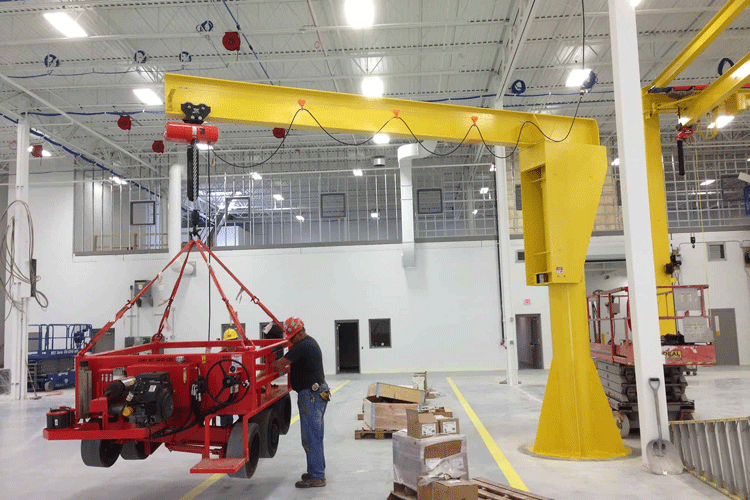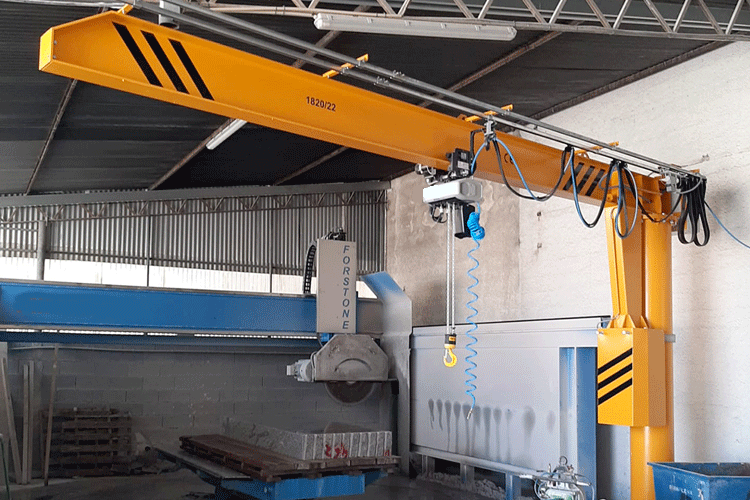Jib crane is an industrial component and is a new generation of light lifting equipment made to adapt to modern production. It is suitable for short-distance, frequent and intensive lifting operations. It has the advantages of high efficiency, energy saving, labor saving, small footprint, easy operation and maintenance.
The basic structure of the cantilever crane consists of a column, a slewing arm rotation drive device and a main machine hoist. The lower end of the column is fixed on the concrete foundation through anchor bolts. The cycloidal pinwheel deceleration device drives the cantilever rotation. The electric hoist runs left and right on the cantilever in a straight line and lifts heavy objects. The crane jib is a hollow steel structure with light weight, large span, large lifting capacity, economy and durability. The built-in traveling mechanism adopts special engineering plastic running wheels with rolling bearings, which have low friction and brisk walking; the small structural size is especially helpful for increasing the hook stroke.

With the continuous updating of technology and in order to better adapt to various working places, cantilever jib cranes have also been constantly updated and iterated from the most basic mechanism, and a variety of types have been extended based on the original structure. The basic classification of cantilever cranes is as follows:
1. Fixed column type, also known as column type/self-standing cantilever crane, can design customized special lifting equipment according to customer needs. The column-type jib crane has the advantages of novel structure, reasonableness, simplicity, convenient operation, flexible rotation, and large working space. It is an energy-saving and efficient material lifting equipment, which can be widely used in the upper and lower work of production lines, assembly lines and machine tools in factories, mines and workshops, as well as the lifting of heavy objects in warehouses, docks and other places.
2. It has the advantages of flexibility and wide adaptability. It can be moved wherever needed. It is a necessary independent emergency hoisting equipment for efficient automatic production lines. With it, it can ensure the smooth flow of the production line.
3. Wall mounted type, also known as pilaster type cantilever crane, refers to hoisting equipment that does not use columns but is directly supported by the wall. It saves space and is more suitable for factories with small spaces. Later on, the wall-type cantilever crane was extended to the wall-type cantilever crane. As the name suggests, moving rails were added along the wall to increase the lifting space.
4. Folding arm type, also known as curved arm type, double arm type, etc., means that the cantilever is no longer single, but consists of two or more sections. It has the characteristics of novel structure, free extension and bending, flexible operation, high efficiency and energy saving. . It is more suitable for production or maintenance occasions in machinery manufacturing, railway, chemical industry, light industry and other industries. Especially in production lines with dense equipment, short-distance lifting and frequent operations, the application of this product can improve production efficiency.

5. Telescopic type, the column can be retracted or the cantilever can be retracted, which is more conducive to movement in narrow areas and has a wider application range.
Choosing the right cantilever crane means that you can save a lot of manpower and material resources in the work area. The handling work that originally required multiple people to operate can be completed with the help of the cantilever crane by one person with high quality and quantity.
